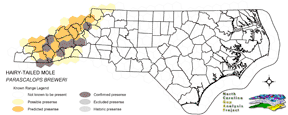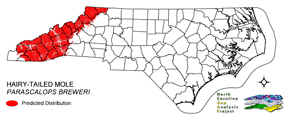
| Taxa: |
| Order: |
| Family: |
| Mammalia |
| Insectivora |
| Talpidae |
| NatureServe Global Rank: |
| NatureServe State (NC) Rank: |
| G5 |
| S4 |
| Federal Status: |
| NC State Status: |
| --- |
| --- |


| Land Unit |
| US Fish & Wildlife Service |
| US Forest Service |
| US National Park Service |
| US Department of Defense |
| NC State Parks |
| NC University System |
| NC Wildlife Res. Com. |
| NC Forest Service |
| NC Div. of Coastal Mgmt. |
| Local Governments |
| Non-Governmental Org. |
| Other Public Lands |
| Private Lands |
| GAP Status 1-2 |
| All Protected Lands |
| Statewide |
| Hectares |
| 0.00 |
| 322,542.90 |
| 0.00 |
| 111,164.85 |
| 3,021.39 |
| 72.63 |
| 4,086.00 |
| 2,568.75 |
| 0.00 |
| 7,040.43 |
| 6,425.55 |
| 157.86 |
| 1,000,165.14 |
| 151,722.51 |
| 456,539.82 |
| 1,457,245.50 |
| Acres |
| 0.00 |
| 797,020.71 |
| 0.00 |
| 274,694.27 |
| 7,466.02 |
| 179.47 |
| 10,096.72 |
| 9,666.39 |
| 0.00 |
| 17,397.28 |
| 15,877.88 |
| 390.08 |
| 2,471,461.40 |
| 378,233.29 |
| 1,131,453.12 |
| 3,604,250.22 |
| % of Dist. on |
| Prot. Lands |
| 0.0 % |
| 70.6 % |
| 0.0 % |
| 24.3 % |
| 0.7 % |
| < 0.1 % |
| 0.9 % |
| 0.6 % |
| 0.0 % |
| 1.3 % |
| 1.3 % |
| < 0.1 % |
| 0.0 % |
| 33.2 % |
| ----- |
| ----- |
| % of Dist. on |
| All Lands |
| 0.0 % |
| 22.1 % |
| 0.0 % |
| 7.6 % |
| 0.2 % |
| < 0.1 % |
| 0.3 % |
| 0.2 % |
| 0.0 % |
| 0.5 % |
| 0.4 % |
| < 0.1 % |
| 68.6 % |
| 10.4 % |
| ----- |
| ----- |
|
Found only in the mountain region of North Carolina at elevations generally above 2000ft (Lee et al. 1982). Primarily a forest or open woodland dweller, but habitats range from pastures with shrubby vegetation to densely wooded forests with well-developed, organic soils (Whitaker and Hamilton 1998). Also taken from cultivated fields, grassy roadsides, and rhododendron thickets (Webster et al. 1985). NATURE SERVE GLOBAL HABITAT COMMENTS: Deciduous woodlands with thick humus. Adapted to second growth stands, old fields, hedgerows. Prefers well-drained, light, moist soil with well-mixed organic matter and minerals. Avoids soils that are hard, dry, or with a large clay content. Two tunnel systems are constructed. Deeper system (10-18' deep) gives resting, breeding space, and winter shelter. Males leave tunnel systems in search of females in breeding season. |
| Code | Name | Description | NC Natural Heritage Program Equivalent |
| 230 | Piedmont Mesic Forest | American Beech - Red Oak - White Oak Forests. | Mesic Mixed Hardwood |
| 383 | Piedmont Mixed Successional Forest | Generally loblolly mixed with successional hardwoods. Sweetgum, tulip poplar and red maple are common co-dominants in these successional forests. | No equivalent |
| 228 | Piedmont Dry-Mesic Oak and Hardwood Forests | Primarily oak dominated forests, white oak is often dominant, with co-dominants including . Also represented by sweetgum and tulip poplar dominated forests. | Dry Mesic Oak Hickory Forest, Basic Oak Hickory Forest, Dry Oak Hickory Forest |
| 222 | Piedmont Dry-Mesic Pine Forests | Loblolly dominated forests resulting from succession following clearing. This type occurs on all moisture regimes following disturbance with the exception of the extremely xeric sites. | No equivalent |
| 382 | Dry Mesic Oak Pine Forests | Mixed forests of the coastal plain and piedmont. Includes loblolly pine with white, southern red and/or post oak and loblolly with water oak. On basic sites of the piedmont, eastern red cedar may co-occur with post, black, and blackjack oaks. | Dry Mesic Oak Hickory Forest, Xeric Hard Pan Forest, Chestnut Oak Forest, Dry Mesic Oak Hickory Forest, Dry Oak Hickory Forest |
| 36 | Successional Deciduous Forests | Regenerating deciduous trees with a shrub stature. Commonly dominated by sweetgum, tulip poplars and maples. | No equivalent |
| 205 | Agricultural Pasture/Hay and Natural Herbaceous | Farm fields used for pasture grass or hay production, as well as old fields dominated by native and exotic grasses. | No equivalent |
| 517 | Hemlock Floodplain Forest | Alluvial forest with hemlock and/or white pine in mountains and western piedmont. Hydrology is generally temporarily to seasonally flooded. | Canada Hemlock Forest |
| 521 | Spruce/Fir Forest | High Elevation Frazer-Fir - Red Spruce, Red Spruce and Red-Spruce-Yellow Birch Forests. Tree densities included here include both woodland to forest density. Highly intermixed with Northern Hardwoods, Grassy Balds, and Shrub Balds. | Red Spruce--Fraser Fir Forest, Fraser Fir Forest |
| 522 | Northern Hardwoods | High Elevation forests including yellow birch, American beech, and yellow buckeye. Includes forests with Hemlock and Yellow Birch. | Northern Hardwoods Forest, Boulderfield Forest |
| 523 | Grassy Bald | High Elevation grassy balds including Pennsylvania sedge, mountain oatgrass, as well as shrubby areas dominated by Alleghany and smooth blackberry. | Grassy Bald |
| 524 | Shrub Bald | Variable phenologies, predominantly evergreen balds with rhododendon and Mountain laurels. Deciduous shrubs including green alder and Alleghany and smooth blackberry are included as well. Red Oak - Chestnut Oak Woodlands may be included in cases where the density of the woodland species is low and the shrub component is dense. | Heath Bald |
| 525 | Appalachian Oak Forest | A variety of oak forest types including Black, White, Scarlet Oaks in dry to mesic situations. Includes forests historically co-dominated by American Chestnut. | High Elevation Red Oak Forest, Montane White Oak Forest |
| 526 | Appalachian Cove Forest | Mixed Mesophytic forests of the mountains. Includes tuliptree, basswood, yellow buckeye and surgar maple. This class is mapped to include cove forests dominated or co-dominated by hemlock. | Rich Cove Forest, Acidic Cove Forest |
| 527 | Appalachian Hemlock | Upland hemlock forests of the moutains region. Vary from side slopes to steep slope positions. | Canada Hemlock Forest |
|
Eadie, W.R. 1939. A contribution to the biology of Parasca- lops breweri. Jour. Mamm. 20:150-173.
Hallt, J.G. 1978. Hairy-tailed mole. Am. Soc. Mamm., Mammalian Species No. 98. 4 pp. Jackson, H. H. T. 1915. A review of the American moles. North American Fauna 38:1-100. Whitaker, J.O. Jr. and W.J. Hamilton, Jr. 1998. Mammals of the eastern United States. Cornell Univ. Press, Ithaca, New York. 583 pp. Lee, D. S., L. B. Funderburg Jr., and M. K. Clark. 1982. A distributional survey of North Carolina mammals. Occasional Papers of the North Carolina Biological Survey, No. 1982-10. North Carolina State. Mus. Nat. Hist., Raleigh, North Carolina. 72 pp. Banfield, A.W.F. 1974. The mammals of Canada. University of Toronto Press, Toronto. Godin, A.J. 1977. Wild Mammals of New England. Johns Hopkins University Press, Baltimore. 304 pp. Hamilton, William J., Jr., and John O. Whitaker, Jr. 1979. Mammals of the eastern United States. Cornell Univ. Press, Ithaca, New York. 346 pp. Hall, E. R. 1981. The Mammals of North America. Second edition. 2 Volumes. John Wiley and Sons, New York, New York. van Zyll de Jong, C. G. 1983. Handbook of Canadian Mammals. 1. Marsupials and insectivores. Nat. Mus. Canada, Ottawa. 212 pp. Webster, W. D., J. F. Parnell and W. C. Biggs Jr. 1985. Mammals of the Carolinas, Virginia, and Maryland. The University of North Carolina Press, Chapel Hill, NC. Gorman, M. L., and R. D. Stone. 1990. The natural history of moles. Cornell Univ. Press. 208 pp. |
For more information please contact them at:
NC-GAP Analysis Project
Dept. of Zoology, NCSU
Campus Box 7617
Raleigh, NC 27695-7617
(919) 513-2853
www.basic.ncsu.edu/ncgap